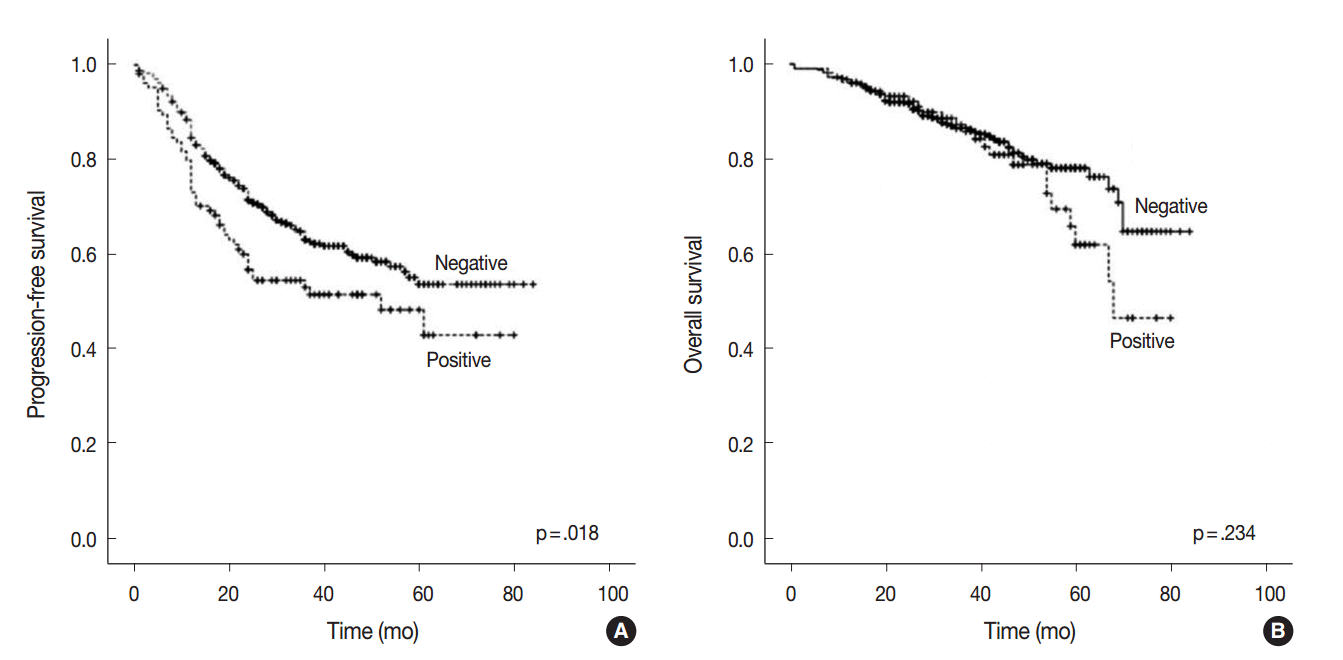Articles
- Page Path
- HOME > J Pathol Transl Med > Volume 50(4); 2016 > Article
-
Original Article
Aquaporin 1 Is an Independent Marker of Poor Prognosis in Lung Adenocarcinoma - Sumi Yun1,2,*, Ping-Li Sun3,*, Yan Jin4, Hyojin Kim1, Eunhyang Park1, Soo Young Park1, Kyuho Lee1, Kyoungyul Lee5, Jin-Haeng Chung,1
-
Journal of Pathology and Translational Medicine 2016;50(4):251-257.
DOI: https://doi.org/10.4132/jptm.2016.03.30
Published online: June 7, 2016
1Department of Pathology, Seoul National University Bundang Hospital, Seongnam, Korea
2Department of Pathology, Soonchunhyang University Hospital, Seoul, Korea
3Department of Pathology, Second Hospital of Jilin University, Changchun, China
4Department of Pathology, Fudan University, Shanghai Cancer Center, Shanghai, China
5Department of Pathology, Kangwon National University Hospital, Chuncheon, Korea
- Corresponding Author Jin-Haeng Chung, MD, PhD Department of Pathology, Seoul National University Bundang Hospital, 82 Gumi-ro 173beon-gil, Bundang-gu, Seongnam 13620, Korea Tel: +82-31-787-7713 Fax: +82-31-787-4012 E-mail: chungjh@snu.ac.kr
- *Sumi Yun and Ping-Li Sun contributed equally to this work.
© 2016 The Korean Society of Pathologists/The Korean Society for Cytopathology
This is an Open Access article distributed under the terms of the Creative Commons Attribution Non-Commercial License (http://creativecommons.org/licenses/by-nc/3.0/) which permits unrestricted noncommercial use, distribution, and reproduction in any medium, provided the original work is properly cited.
Figure & Data
References
Citations

- The Expanding Role of Aquaporin-1, Aquaporin-3 and Aquaporin-5 as Transceptors: Involvement in Cancer Development and Potential Druggability
Catarina Pimpão, Inês V. da Silva, Graça Soveral
International Journal of Molecular Sciences.2025; 26(3): 1330. CrossRef - The comprehensive potential of AQP1 as a tumor biomarker: evidence from kidney neoplasm cohorts, cell experiments and pan-cancer analysis
Yifan Liu, Donghao Lyu, Yuntao Yao, Jinming Cui, Jiangui Liu, Zikuan Bai, Zihui Zhao, Yuanan Li, Bingnan Lu, Keqin Dong, Xiuwu Pan
Human Genomics.2025;[Epub] CrossRef - Clinical application of cold atmospheric-pressure plasma: mechanisms and irradiation conditions
Eun Ji Jeong, Hyun Min Park, Dong Jae Lee, Jun Lee, Jun Yeong Cho, Kyung Deok Seo, Seokjun Je, Min Hyung Jung, Woo Yeon Hwang, Kyung Sook Kim
Journal of Physics D: Applied Physics.2024; 57(37): 373001. CrossRef - Aquaporins in Cancer Biology
Chul So Moon, David Moon, Sung Koo Kang
Frontiers in Oncology.2022;[Epub] CrossRef - A Comprehensive Prognostic Analysis of Tumor-Related Blood Group Antigens in Pan-Cancers Suggests That SEMA7A as a Novel Biomarker in Kidney Renal Clear Cell Carcinoma
Yange Wang, Chenyang Li, Xinlei Qi, Yafei Yao, Lu Zhang, Guosen Zhang, Longxiang Xie, Qiang Wang, Wan Zhu, Xiangqian Guo
International Journal of Molecular Sciences.2022; 23(15): 8799. CrossRef - Differential modulation of lung aquaporins among other pathophysiological markers in acute (Cl2 gas) and chronic (carbon nanoparticles, cigarette smoke) respiratory toxicity mouse models
Sukanta S. Bhattacharya, Brijesh Yadav, Ekta Yadav, Ariel Hus, Niket Yadav, Perminder Kaur, Lauren Rosen, Roman Jandarov, Jagjit S. Yadav
Frontiers in Physiology.2022;[Epub] CrossRef - Aquaporin water channels as regulators of cell-cell adhesion proteins
Sarannya Edamana, Frédéric H. Login, Soichiro Yamada, Tae-Hwan Kwon, Lene N. Nejsum
American Journal of Physiology-Cell Physiology.2021; 320(5): C771. CrossRef - Targeting Aquaporins in Novel Therapies for Male and Female Breast and Reproductive Cancers
Sidra Khan, Carmela Ricciardelli, Andrea J. Yool
Cells.2021; 10(2): 215. CrossRef - Targeting ion channels for the treatment of lung cancer
Liqin Zhang, Shuya Bing, Mo Dong, Xiaoqiu Lu, Yuancheng Xiong
Biochimica et Biophysica Acta (BBA) - Reviews on Cancer.2021; 1876(2): 188629. CrossRef - Comprehensive Analysis of Aquaporin Superfamily in Lung Adenocarcinoma
Guofu Lin, Luyang Chen, Lanlan Lin, Hai Lin, Zhifeng Guo, Yingxuan Xu, Chanchan Hu, Jinglan Fu, Qinhui Lin, Wenhan Chen, Yiming Zeng, Yuan Xu
Frontiers in Molecular Biosciences.2021;[Epub] CrossRef - Diagnostic accuracy of urinary aquaporin-1 as a biomarker for renal cell carcinoma
Abhilash Cheriyan, Arun Jose Nellickal, Nirmal Thampi John, Lakshmanan Jeyaseelan, Santosh Kumar, Antony Devasia, Nitin Kekre
Indian Journal of Urology.2021; 37(1): 59. CrossRef - Aquaporin 1, 3, and 5 Patterns in Salivary Gland Mucoepidermoid Carcinoma: Expression in Surgical Specimens and an In Vitro Pilot Study
Mérin Barbara Stamboni, Ágatha Nagli de Mello Gomes, Milena Monteiro de Souza, Katia Klug Oliveira, Claudia Fabiana Joca Arruda, Fernanda de Paula, Barbara Beltrame Bettim, Márcia Martins Marques, Luiz Paulo Kowalski, Clóvis Antônio Lopes Pinto, Victor El
International Journal of Molecular Sciences.2020; 21(4): 1287. CrossRef - Combined Systematic Review and Transcriptomic Analyses of Mammalian Aquaporin Classes 1 to 10 as Biomarkers and Prognostic Indicators in Diverse Cancers
Pak Hin Chow, Joanne Bowen, Andrea J Yool
Cancers.2020; 12(7): 1911. CrossRef - Aquaporins in lung health and disease: Emerging roles, regulation, and clinical implications
Ekta Yadav, Niket Yadav, Ariel Hus, Jagjit S. Yadav
Respiratory Medicine.2020; 174: 106193. CrossRef - Dissecting gene‐environment interactions: A penalized robust approach accounting for hierarchical structures
Cen Wu, Yu Jiang, Jie Ren, Yuehua Cui, Shuangge Ma
Statistics in Medicine.2018; 37(3): 437. CrossRef - Immunohistochemical Expression of Aquaporin-1 in Fluoro-Edenite-Induced Malignant Mesothelioma: A Preliminary Report
Giuseppe Angelico, Rosario Caltabiano, Carla Loreto, Antonio Ieni, Giovanni Tuccari, Caterina Ledda, Venerando Rapisarda
International Journal of Molecular Sciences.2018; 19(3): 685. CrossRef - Mechanisms of Aquaporin-Facilitated Cancer Invasion and Metastasis
Michael L. De Ieso, Andrea J. Yool
Frontiers in Chemistry.2018;[Epub] CrossRef - Aquaporin 1 suppresses apoptosis and affects prognosis in esophageal squamous cell carcinoma
Yuzo Yamazato, Atsushi Shiozaki, Daisuke Ichikawa, Toshiyuki Kosuga, Katsutoshi Shoda, Tomohiro Arita, Hirotaka Konishi, Shuhei Komatsu, Takeshi Kubota, Hitoshi Fujiwara, Kazuma Okamoto, Mitsuo Kishimoto, Eiichi Konishi, Yoshinori Marunaka, Eigo Otsuji
Oncotarget.2018; 9(52): 29957. CrossRef - Aquaporin 1 expression is associated with response to adjuvant chemotherapy in stage�II and III colorectal cancer
Hideko Imaizumi, Keiichiro Ishibashi, Seiichi Takenoshita, Hideyuki Ishida
Oncology Letters.2018;[Epub] CrossRef - Aquaporin 3 facilitates tumor growth in pancreatic cancer by modulating mTOR signaling
Xunwei Huang, Li Huang, Minhua Shao
Biochemical and Biophysical Research Communications.2017; 486(4): 1097. CrossRef - Prognostic implication of aquaporin 1 overexpression in resected lung adenocarcinoma†
Guido Bellezza, Jacopo Vannucci, Fortunato Bianconi, Giulio Metro, Rachele Del Sordo, Marco Andolfi, Ivana Ferri, Paola Siccu, Vienna Ludovini, Francesco Puma, Angelo Sidoni, Lucio Cagini
Interactive CardioVascular and Thoracic Surgery.2017; 25(6): 856. CrossRef
 PubReader
PubReader ePub Link
ePub Link-
 Cite this Article
Cite this Article
- Cite this Article
-
- Close
- Download Citation
- Close
- Figure


Fig. 1.
Fig. 2.
| Variable | Total | AQP1 overexpression |
||
|---|---|---|---|---|
| Negative | Positive | p-value | ||
| Sex | .938 | |||
| Male | 247 | 196 (79.4) | 51 (20.6) | |
| Female | 258 | 204 (79.1) | 54 (20.9) | |
| Age (yr) | .092 | |||
| ≤ 60 | 181 | 136 (75.1) | 45 (24.9) | |
| > 60 | 324 | 264 (81.5) | 60 (18.5) | |
| Smoking history | .347 | |||
| Non-smoker | 302 | 235 (77.8) | 67 (22.2) | |
| Smoker | 203 | 165 (81.3) | 38 (18.7) | |
| Tumor size (cm) | .145 | |||
| ≤ 3 | 276 | 212 (76.8) | 64 (23.2) | |
| > 3 | 229 | 188 (82.1) | 41 (17.9) | |
| Histological grade | .097 | |||
| G1 | 34 | 30 (88.2) | 4 (11.8) | |
| G2 | 390 | 312 (80.0) | 78 (20.0) | |
| G3 | 81 | 58 (71.6) | 23 (28.4) | |
| Acinar predominant | .368 | |||
| No | 207 | 168 (81.2) | 39 (18.8) | |
| Yes | 298 | 232 (77.9) | 66 (22.1) | |
| Papillary predominant | .120 | |||
| No | 422 | 339 (78.0) | 93 (22.0) | |
| Yes | 83 | 71 (85.5) | 12 (14.5) | |
| Lepidic predominant | .087 | |||
| No | 472 | 370 (78.4) | 102 (21.6) | |
| Yes | 33 | 30 (90.9) | 3 (9.1) | |
| Solid predominant | .233 | |||
| No | 432 | 346 (80.1) | 86 (19.9) | |
| Yes | 73 | 54 (74.0) | 19 (26.0) | |
| Others |
.552 | |||
| No | 487 | 387 (79.5) | 100 (20.5) | |
| Yes | 18 | 13 (72.2) | 5 (27.8) | |
| Pleural invasion | .131 | |||
| Absent | 283 | 231 (81.6) | 52 (18.4) | |
| Present | 222 | 169 (76.1) | 53 (23.9) | |
| Venous invasion | .035 |
|||
| Absent | 377 | 307 (81.4) | 70 (18.6) | |
| Present | 130 | 93 (72.7) | 35 (27.3) | |
| Lymphatic invasion | .039 |
|||
| Absent | 252 | 209 (82.9) | 43 (17.1) | |
| Present | 253 | 193 (75.5) | 62 (24.5) | |
| Perineural invasion | .290 | |||
| Absent | 469 | 369 (78.7) | 100 (21.2) | |
| Present | 36 | 31 (86.1) | 5 (13.9) | |
| pTNM stage | .072 | |||
| I–II | 367 | 298 (81.2) | 69 (18.8) | |
| III–IV | 138 | 102 (73.9) | 36 (26.1) | |
| Recurrence | .029 |
|||
| No | 311 | 256 (82.3) | 55 (17.7) | |
| Yes | 194 | 144 (74.2) | 50 (25.8) | |
| Death | .130 | |||
| No | 415 | 334 (80.5) | 81 (19.5) | |
| Yes | 90 | 66 (73.3) | 24 (26.7) | |
| EGFR mutation (n = 484) | .583 | |||
| Wild type | 247 | 193 (78.1) | 54 (21.9) | |
| Mutant type | 237 | 190 (80.2) | 47 (19.8) | |
| KRAS mutation (n = 413) | .326 | |||
| Wild type | 388 | 311 (80.2) | 77 (19.8) | |
| Mutant type | 25 | 18 (72.0) | 7 (28.0) | |
| ALK translocation (n = 440) | .089 | |||
| Wild type | 412 | 334 (81.1) | 79 (18.9) | |
| Mutant type | 28 | 19 (67.9) | 9 (32.1) | |
| Variable | Total | AQP1 overexpression |
||
|---|---|---|---|---|
| Negative | Positive | p-value | ||
| E-Cadherin expression (n = 479) | .011 |
|||
| Decreased | 201 | 147 (73.1) | 54 (26.9) | |
| Preserved | 278 | 230 (82.7) | 48 (17.3) | |
| Vimentin expression (n = 471) | < .001a | |||
| Negative | 279 | 238 (85.3) | 41 (14.7) | |
| Positive | 192 | 133 (69.3) | 59 (30.7) | |
Values are presented as number (%). AQP1, aquaporin 1; EGFR, epidermal growth factor receptor; ALK, anaplastic lymphoma kinase. Invasive mucinous and micropapillary subtype; Statistically significant value.
Values are presented as number (%). AQP1, aquaporin 1; EMT, epithelial-mesenchymal transition. Statistically significant value.

 E-submission
E-submission






